Facts About The Common Myrtle Tree
The Common, or "True," Myrtle
The common myrtle (Myrtus communis), also known as the true myrtle, is a broadleaf evergreen shrub, although in some cases, it can grow in the form of a small tree. These flowering trees and shrubs are native to the Mediterranean.
The common myrtle is hardy in USDA hardiness zones 8 through 10. Outside its growing zone, it can be grown in containers and overwintered indoors.
Myrtle Tree Identification
The common myrtle should not be confused with the crape myrtle (Lagerstroemia indica; zones 6 to 9), sometimes spelled "crepe" myrtle, which is a large shrub native to Asia that has naturalized in parts of the U.S. While the common myrtle has white flowers, the crape myrtle may have pink, purple or red flowers, depending on the cultivar.
Tip
The common myrtle is a species distinct from the crape myrtle.
Some of the features of the common myrtle include:
Size
The common myrtle tree is usually 5 to 6 feet tall; however, it is capable of reaching a mature size of up to 12 feet, with a similar width, under certain conditions.
There are several cultivars of the myrtle tree to choose from, including a dwarf version that grows to heights between 2 and 3 feet.
Leaves
Myrtle tree leaves may grow up to 2 inches long. They are oval- or lance-shaped and have a glossy green surface. The undersides of the leaves are a paler green color.
The leaves are usually opposite, which means that two leaves are attached to a single node, one on each side of the stem. The leaves produce a strong fragrance when crushed.
Because the leaves of the true myrtle are evergreen, unlike the deciduous leaves of crape myrtle trees, this plant does not produce fall color.
Flowers
Myrtle tree flowers are showy, with white petals and a profusion of stamens—the male reproductive organ of flowers—that have white tips. Each flower is about 3/4 inch wide and quite fragrant.
The myrtle tree is a good option if you are looking for summer flowers, because the species blooms from May to July.
Fruit
Common myrtle plants produce dark blue berries that, when ripe, look almost black. The fruit is edible; however, it's not considered particularly flavorful.
Bark
Young myrtle plants have smooth gray bark. As the tree ages, the bark peels back in chunks to reveal a layer of bark in a different color.
Myrtle Tree Care
The true myrtle tree is a low-maintenance species that can grow in full sun or part shade.
Myrtle trees must be grown in well-draining soil to prevent root rot from occurring. Once these plants are established, they are considered drought tolerant.
Frosts in early spring can cause damage to new growth.
Myrtle Tree Uses
In ancient times, the civilizations of the Mediterranean used various parts of myrtle plants for medicinal purposes and as cooking ingredients. In fact, the leaves of the myrtle plant are sometimes used as substitutes for bay leaves in various recipes.
The wood of the myrtle tree is used in barbecue charcoals to add flavor to meat.
In the landscape, myrtle plants can be grown as specimens or foundation plantings or pruned into hedges.

